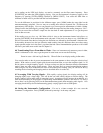6
comparative measurement between different devices or conditions its accuracy can approach the 100db or
10db ranges precision of .1db or .01db, we’ll talk about that in Chapter 16.
To maintain accuracy the HP3586 does a 3 second duration automatic calibration, auto cal, when it’s first
turned on, every two minutes during operation, if its frequency is changed more than 1MHz, and when a
new measuring range width is selected. If any problems arise during calibration or during its operation the
display will output error codes, which are described in Append B. For special reasons such as SSB audio
tuning discussed in this document, the auto cal feature can be turned off at any time after its initial power
up.
2.4 The 004 Option – When I purchased my HP3586B I assumed it didn’t have the 004 enhanced
frequency accuracy option but I noticed a 004 installed sticker on its back panel. Also there was an oven
output connector installed on its back panel but no jumper from this connector to the external reference
connector just to its right. I then removed the instrument’s top cover by loosening a screw in the back of
the cover and sliding the cover off. To my delight I found a wire from the oven connector to a module
labeled A16 installed to the RH rear of the instrument’s motherboard, which was the 004 option module
with the 10 MHz crystal standard in a oven.
When I connected a jumper between these two connectors the oven light on my front panel came on for
about 10 minutes and then went off. After the oven light went out indicating the crystal oven was up to
temperature, checked WWV on 10 MHz using the counter procedure in section 5.3 of chapter 5 and found
my instrument was within .7 cycles of 10 MHz when using the counter on WWV’s 10 MHz carrier.
Without the jumper installed between the connectors, it was off by over 9 cycles so activating the 004
option made a great difference in the frequency accuracy of my instrument.
If the oven connector is installed on the back panel of your instrument but isn’t connected to the EXT REF
connector to its right, look inside your instrument and maybe you will be lucky and have this valuable
option. If your instrument has the A16 module installed, you must connect a jumper cable with two BNC
male connectors to activate the option.
2.5 Level Measuring Modes – The HP3586 family of instruments has the following modes for
measuring signal levels:
SELECTIVE See Chapters 4, 5, 6, 7 and 9
CARRIER See Chapter 8
NOISE/DEMODULATION See Chapter 10
WIDEBAND See Chapter 11
IMPULSE See Chapter 12
NETWORK ANALYSIS See Chapter 14
TONE Not Applicable
JITTER Not Applicable
I have found the first six measurement modes useful for radio and audio measurements. The other modes
are not normally useful because they are designed specifically for telephone measurements or require other
not normally available specialized equipment.
All measurement modes discussed in this document apply to the A and B versions where the
noise/demodulation, impulse and carrier modes are not available on the HP3586C general purpose version.
However, I’ll show how to make noise/demodulation measurements with the selective mode using the C
version.


















